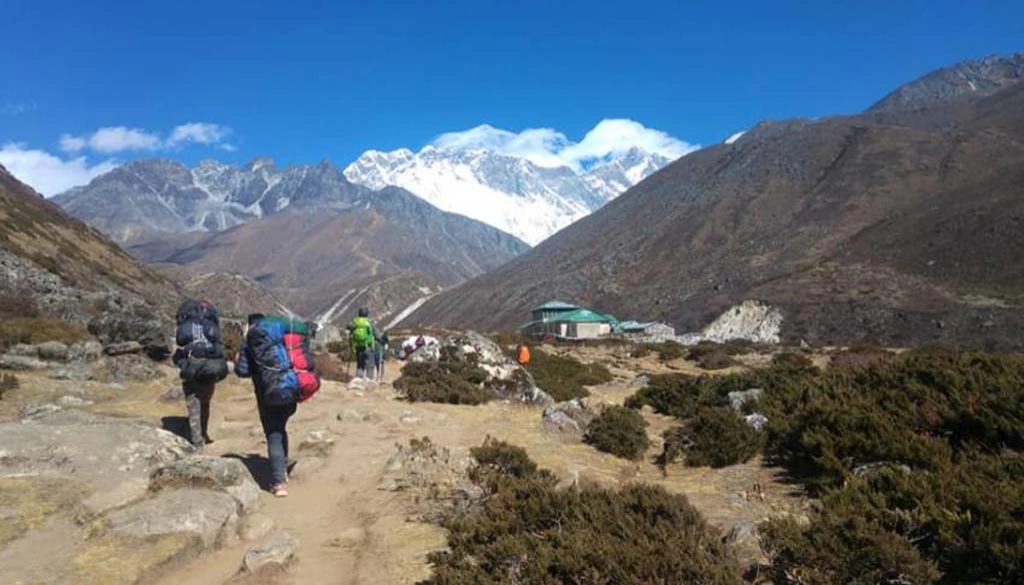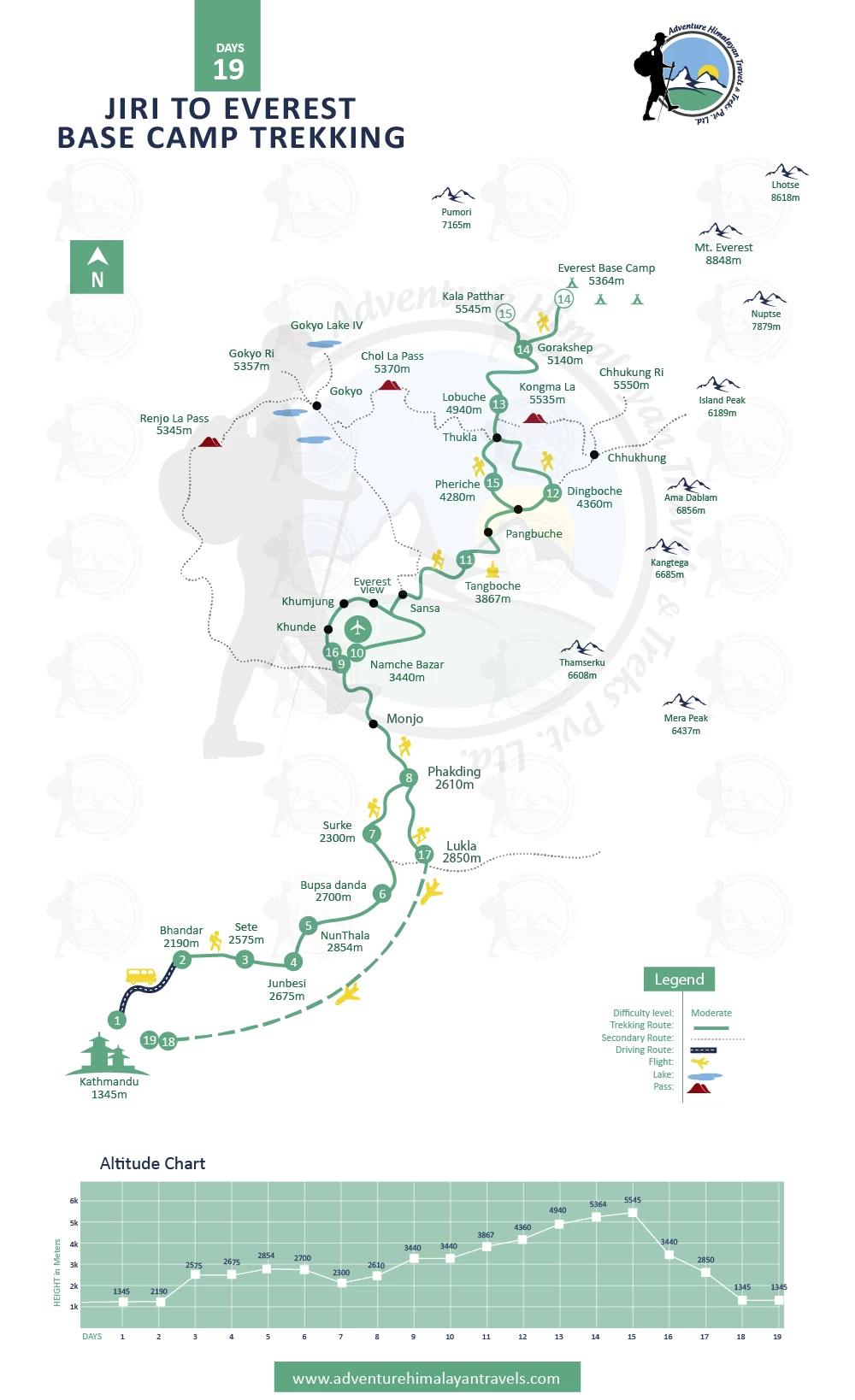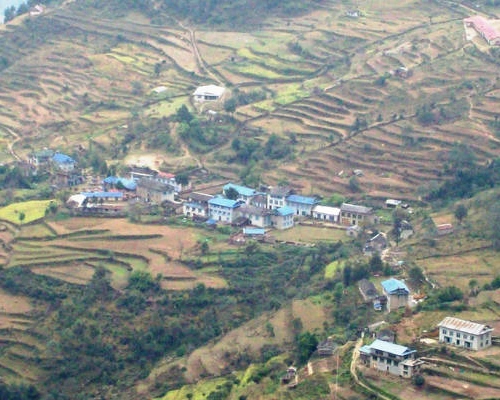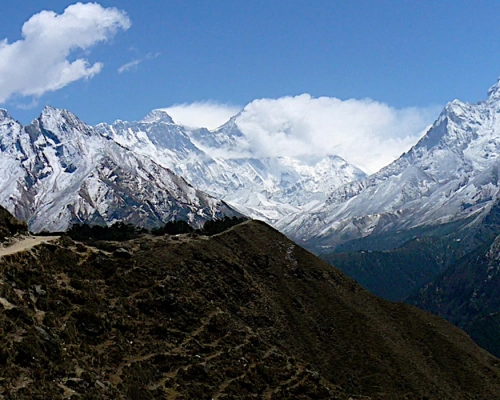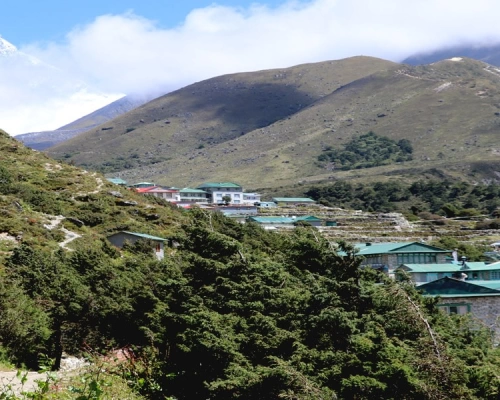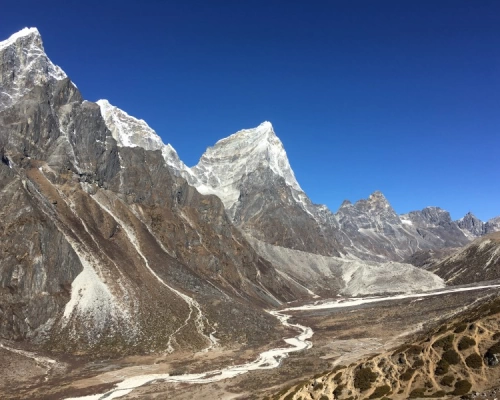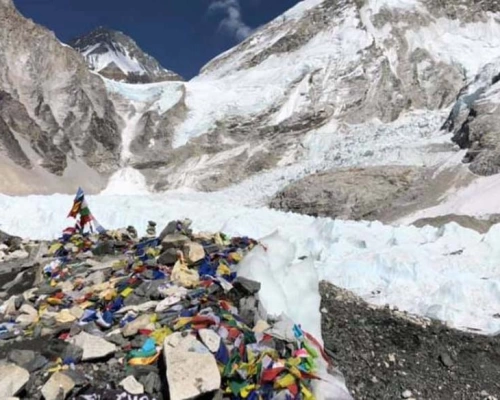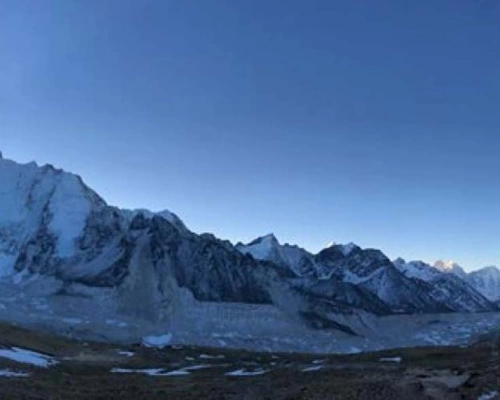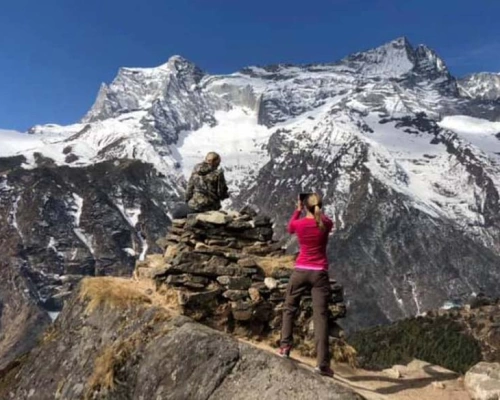The Jiri to Everest Base Camp (EBC) Trek is a classic Himalayan adventure that retraces the footsteps of early Everest pioneers, including the legendary mountaineers Sir Edmund Hillary and Tenzing Norgay Sherpa, before the Lukla airport was built, which is used as the contemporary gateway to any trekking, climbing, and expedition in Everest, such as Everest Gokyo Lake Trek via Cho La Pass, Everest Three Pass, and many more. Starting from Jiri, unlike the popular Lukla to EBC route, trekkers ascend gradually to high altitude, allowing more natural and profound acclimatization while experiencing the diverse culture and landscapes of Nepal.
This specific Everest Base Camp Trekking route is also known as the original route to reach the base camp of the highest peak in the world, Mount Everest, even to summit the peak itself at an altitude of 8,848 m above sea level. This trekking trail in the Everest region meanders through scenic terraced farms, lush forests, and charming traditional villages before joining the main EBC trail in Phakding along the bank of the Dudh Koshi River of the Khumbu Valley, catering to trekkers, climbers, and mountaineers alike, rewarded with breathtaking views of sky-perching mountain peaks like Thamserku, Ama Dablam, and eventually the majestic Mount Everest.
A typical itinerary for the Jiri to Everest Base Camp trek begins with an overland drive to Jiri from Kathmandu, followed by a walk through the traditional villages like Sete, Junbesi, and Nunthala before joining the primary trail that proceeds through Phakding, Namche Bazaar, Tengboche, Dingboche, Lobuche, and Gorak Shep before finally reaching the Everest Base Camp and the highest point at Kala Patthar. The round trip spans about 19-22 days and goes through the lower belts of the Khumbu region, its unique traditional Sherpa culture, and pristine natural beauty, offering a slower-paced, immersive trekking experience.
Though choosing this classic Himalayan route to the Everest Base Camp (EBC) does add about a week to the standard Everest Base Camp and Kala Patthar Trek, major highlights include a visit to Tengboche Monastery, an acclimatization day at Namche Bazaar, an alpine ascent to Everest Base Camp, and a sunrise side hike to Kala Patthar, providing unparalleled views of Mount Everest and its surrounding peaks in serenity. It is well worth the effort. The extra walk days provide a deeper connection with the local culture and nature of the lower Khumbu Valley apart from the densely crowded Lukla route.
In comparison to the normal Everest Trek package, this Jiri to Everest Base Camp Trek is lengthier, perfect for those seeking an off-the-beaten-path experience; it is also slightly costlier. To conclude, regardless of the budget, the trek to Everest Base Camp from Jiri is a rewarding journey fostering a deeper appreciation for the grandeur of the Everest region under one of the natural UNESCO World Heritage Sites from Nepal, the Sagarmatha National Park, as you gradually transit from lush subtropical land to the rugged beauty of the Himalayas in stark contrast.
What makes Jiri to Everest Base Camp Trek special?
The Jiri to Everest Base Camp Trekking is both a physically demanding and rewarding Himalayan voyage that includes several days of trekking across steep ascents and descents for at least 5-7 hours a day, even to reach Phakding and then Namche Bazaar also called the official gateway to the Everest Himalayas of Nepal. Along the way, trekkers can expect to cross several adrenaline-rushing suspension bridges, embark on high-altitude passes like the Lamjura La, visit small yet lovely Himalayan settlements, and relish panoramic views of the majestic Himalayan peaks for longer days.
This particular Everest Himalayan route is ideal for adventurers seeking an authentic experience that merges with the standard EBC route at Phakding, moving forth to the Dudh Koshi River Valley and the awe-inspiring Khumbu Glacier and the base camp of Everest itself, requiring good stamina and endurance. This extended itinerary route combines the cultural richness, physical challenge, and unmatchable natural beauty in a single package, making it one of Nepal’s most beloved treks in the world to experience what the previous mountaineers, climbers, and trekkers did before the construction of Lukla airport in 1964 A.D.
Experience the historical route through the diverse landscape of the Sagarmatha National Park
One of the key features that set the trek to Everest Base Camp from Jiri apart is the sense of nostalgia and connection to the early days of the Everest Trek, hike, and expeditions, famous as the classic route once used by Sir Edmund Hillary and Tenzing Norgay Sherpa during their historic Everest summit in 1953. Starting from Jiri, around 188 km east of Kathmandu, approximately an 8-9 hour drive from the city, the trek passes through diverse landscapes of the Sagarmatha National Park, a UNESCO World Heritage Site.
In the lower altitude, you will traverse the lush green valleys, terraced farmlands, rhododendron forests, and vibrant villages of mixed ethnic communities. As you reach the mid-altitude around Namche Bazaar, Tengboche, Dingboche, and Lobuche, the trail becomes steeper with dense forests and suspension bridges connecting the remote Sherpa valleys. At the same time, higher altitudes, such as Everest Base Camp and Kala Patthar, 5,000 m+ above sea level, are noted for rocky paths, glacial rivers, high-altitude terrain, and snow-covered landscapes, culminating in top-notch views of iconic Himalayan peaks like Everest, Lhotse, and Ama Dablam.
Following the footsteps of early Everest expeditors, the Jiri to Everest Base Camp Trekking route offers a stunning tapestry of natural beauty marking its way through traditional Sherpa villages, ancient monasteries, suspension bridges, and high alpine terrain to remember for a lifetime.
Stunning Himalayan Scenery
For this Jiri to Everest Base Camp (EBC) Trek, Jiri is the trek starting point in the Himalayas' lower foothills at 1,905 m/6,250 ft. From here, trekkers can enjoy the Himalayan allure of Gaurishankar (7,134m), Number Himal (6,958m), and Dudh Kunda Peak, mostly visible in the initial trekking stage. As you trek further from here, the view expands as you proceed to reach the Everest Base Camp (EBC), passing through verdant hills, terraced farms, and cascading waterfalls.
As you enter the Sagarmatha National Park, Everest, Lhotse, Nuptse, Ama Dablam, Thamserku, and other notable Everest Himalayas dominate the sky horizon, much more spectacular from the high vantage points such as Namche Bazaar and its surrounding peaks, Kala Pattar, and the Everest Base Camp itself. Among these, also the Kala Patthar, at an elevation of 5,545m above sea level, is particularly famous for its 360-degree full view of the Himalayan giants, especially during sunrise when the sun paints the Everest massif and surroundings in golden hues.
The overall journey itself is a visual feast unveiling the hidden beauty of the Everest Trekking region from Jiri. The landscapes are beautiful, dotted with terraced fields, dense forests of oak, pine, and rhododendron, waterfalls, and rugged valleys, resulting in a picturesque backdrop, offering out-of-the-world beauty at every turn.
Mixed cultural Everest experience
The Jiri to Everest Base Camp Trekking Route passes through several remote villages inhabited by diverse ethnic groups of Nepal, like Rai, Tamang, Magar, and Sherpa communities. As you begin hiking from Jiri and journey through the lower foothills such as Bhandar, Sete, Junbesi, Nun Thala, Buspa, and Surkhe before making it to Phakding, you will pass through villages inhabited by Tamang, Magar, and Rai communities and get to experience their unique culture, customs, vibrant festivals, and traditional farming practices.
Trekkers get to experience authentic hospitality, observe local customs, visit Buddhist monasteries, and even participate in the simple lifestyle of mountain people, especially that of Sherpas in the high altitude from Phakding onwards. Renowned as the “Tigers of Snow” for their extraordinary mountaineering skills and reliance on high altitude, Sherpas are an integral part of successful Himalayan treks, hikes, expeditions, and summits. This trek from Jiri to Everest Base Camp creates an opportunity for trekkers to understand the way of life of Sherpas, their mountaineering heritage, and Buddhist culture as you spend the night in the several local tea houses, lodges, and guest houses along the way.
Trekkers get to visit sacred monasteries like Tengboche, the largest of its kind in the Everest Region, serving as the center of Tibetan Buddhism in serenity, spin prayer wheels, and walk past Mani Walls. The cultural immersion is further enhanced by interactions with locals, where local guides bridge the cultural and language gap, friendly nature, warm hospitality, and local Himalayan cuisine, allowing a deeper connection to the country’s diverse heritage in harmony.
Off the beaten Everest Trekking Trail
Unlike the tourist influx on the Lukla Everest Base Camp (EBC) route and other routes such as the Everest Cho La Pass Trek and the Everest Base Camp to Kala Patthar Trek, which typically begin with a short flight from Kathmandu to Lukla, the trek from Jiri is much quieter, less commercialized, and extended, offering a more serene and peaceful trekking experience in one of the most popular trekking destinations in the world, the Everest region.
This trekking trail to reach the Everest Base Camp includes making its way through the untouched parts of the Everest Himalayas and remote villages, providing an incredible nature escape from massively commercialized routes. Trekkers get to enjoy authentic Nepalese rural life and tranquil mountain vistas in solitude, perfect for those seeking a more traditional approach to the Everest Trek.
Further, compared to the standard 12-14 days for the Lukla Everest Base Camp Trek, the route from Jiri takes around 19-22 days, allowing for more time to explore the Sagarmatha National Park, the Everest Himalayas, and the traditional way of life in pristine nature intimately. Starting from a lower altitude, the longer days to ascend also provide better acclimatization opportunities without having to rush the pace, which is immensely helpful in reducing the risk of acute mountain sickness (AMS) or altitude sickness in high altitudes.
Iconic Everest Highlight: Namche Bazaar, Tengboche, Everest Base Camp, and Kala Patthar
The Jiri to Everest Base Camp Trekking is a unique journey through historical, cultural, and natural landmarks of the Everest Trekking region, including Namche Bazaar, Tengboche, Kala Patthar, and the Everest Base Camp (EBC) itself at 5,364 m/17,598 ft above sea level. Though each step has something unique for trekkers to marvel at, these monuments stand out as the epitome of each distinctive area, such as Namche Bazaar as the cultural and trade hub. Known as the official gateway to Everest, Namche Bazaar is the bustling Sherpa capital at an elevation of 3,440 m above sea level and is a vibrant hub for culture, commerce, and acclimatization.
The town offers the first-ever view of the top of the world, Mt. Everest (8,848 m), for those embarking on the classic Everest Base Camp of the Everest Expedition. Despite the region's remoteness, it has several shops, cafes, and tea houses, some even offering luxury private rooms and Western cuisines like pizzas, sandwiches, and burgers. The Sherpa town holds a weekly local market and is one of the main trading hubs in proximity to high-altitude places like Kungde, Khumjung, Everest View Hotel, and others, perfect to take a rest after a hike for acclimatization purposes.
Similarly, yet another highlight of the classic Jiri to Everest Base Camp (EBC) Trek is the Tengboche Monasteryat 3,867 m amidst the gigantic mountain peaks. Revered by locals with close cultural ties with people from Tibet following Tibetan Buddhism, the monastery is said to be one of the largest monasteries in the Khumbu region that hosts the region’s biggest festival, Mani Ridum. Set in the lap of the Himalayas with awe-inspiring views of Ama Dablam, Everest, and other peaks, it is the spiritual haven. A must to visit for individuals seeking spiritual guidance in serenity for both locals and tourists.
Likewise, the Everest Base Camp is the prime destination of the Jiri to Everest Base Camp Trekking route at 5,364 m on the southern face of the highest mountain in the world, Mount Everest. It is the closest you can be to the majestic peak that has been a global sensation since its discovery. Standing here offers a surreal experience amidst the towering ice giants and dramatic glaciers called the Khumbu glacier as you also get to meet brave climbers preparing for the final summit. It is a legendary destination, making it a bucket list adventure for trekkers worldwide.
Last but not least, Kala Patthar is the prime viewpoint for the Jiri to Everest Base Camp Trek. It is also the highest point of this Himalayan voyage at 5,545 m with the best close-up views of Mount Everest and neighboring peaks without summiting Everest itself. Early morning is the best time to visit this iconic viewpoint near Everest Base Camp (EBC) and Gorak Shep to witness the sunrise when the golden light on Everest and the surrounding Himalayas, along with the Khumbu Icefall and logical beauty, crafts a mythical view offering a visual retreat to the eyes.
Jiri to Everest Base Camp Trek 19 Days Itinerary
The Jiri Everest Base Camp Trekking 19 Days itinerary officially commences with a bus drive to Jiri, which is located east of Kathmandu on the second day after you arrive in Kathmandu, Nepal. During the autumn and spring seasons, one can take a bus drive directly up to Salleri. From this place, the walking journey starts. The most ravishing part of this trekking in Nepal is the wonders of Mother Nature and the multiethnic people villages. Unlike the contemporary Everest Base Camp Trek route, the trail showcases plenty of green, lush forests, streams, waterfalls, and villages. Places like Nunthala, Bupsa, and Surke will be on the way before reaching Phakding to meet the modern EBC trek trail. On the way, rhododendrons, pines, magnolias, and many more types of vegetation can be experienced. Villages of Rai and Sherpa communities, along with their terraced farmlands, endow different understandings of rural Nepalese people residing near Mt. Everest.
Once you have trekked for more than three days, you will reach Phakding. Then you will follow the normal modern route towards Everest Base Camp. For the return trip, you will board the mountain flight from Lukla to Kathmandu. Lukla is noted as one of the world’s most extreme airports, while Kathmandu Sightseeing will be the last step in this journey to Nepal. This itinerary allows a comprehensive trekking experience with gradual acclimatization commencing from a lower altitude in Jiri and a rest/exploration day in key stops like Namche Bazaar, balanced physical challenges, and full cultural and scenic highlights of the Everest Himalayas, where buffer days also can be separated for unpredictable events like bad weather, minor health issues, and slower trekking pace. This 19-day itinerary and route gives a holistic trekking experience. Hence, it is also considered one of the best routes to reach the Everest Base Camp (EBC) even in the years 2025 and 2026.
Or, get a tailor-made itinerary to the Everest Himalayas at Adventure Himalayan Travels and Treks as per your preferences, area of interest, time constraints, and the services you are looking forward to. We excel at crafting personalized journeys from standard, budget-friendly, to premium packages as per our client's requirements. Contact us now; we make your dream come true, whether it is to reach the Annapurna Base Camp, or explore the “Hidden Kingdom of Lho,” Upper Mustang, or Tsum Valley.
19-Days Jiri to Everest Base Camp Trekking Cost for 2025 and 2026
Adventure Himalayan Travels and Treks in Nepal is offering group discounts on the Jiri to Everest Base Camp Trek Cost and special discounts on groups of trekkers with more than 10 pax, which are as follows for 2025 and 2026:
- USD 1,775 for 1 pax
- USD 1,675 for 2-3 pax
- USD 1575 for 4-6 pax
- USD 1575 for 7-10 pax
This Jiri to Everest Base Camp Trekking package cost from Adventure Himalayan Travels and Treks covers expenses for all the essential logistics for a more seamless holiday experience in the Everest Himalayas, such as permits, transportation, accommodation guides, salaries, and meals. Although any change in itinerary or mode of accommodation and menu can add to the overall package cost, we promise you the most competitive, affordable, and reasonable itineraries. Contact us now and secure your seat.
